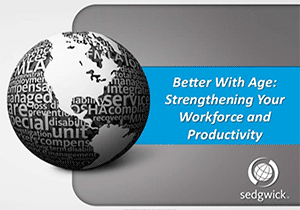
Do you have a family member who is still working well past retirement age? You're not alone. A recent AARP study reported that 70% of U.S. workers plan on working past retirement age. In 2008, there were 28 million workers in the American workforce over the age of 55. By 2016, studies show there will be 40 million workers in this category – a 43% increase, when our younger workforce is only expected to increase by 5-7%.
Some of the reasons for the increase in this age group are:
- Baby Boomer generation: reaching retirement age
- Economic struggles: we are still experiencing a decline in home values and a low return on 401k plans
- Rising healthcare costs: a 65-year-old couple with median prescription costs can currently expect to pay $283,000 for medical bills throughout retirement*
- Declining pensions: only 60% of companies still offer a pension plan
This demographic shift is requiring companies to change the way they think about employee safety, wellness programs, benefit and insurance packages, and even return-to-work strategies after an accident or illness occurs. At Sedgwick, we are embracing the change and realize the value of the older worker. We recommend developing strategies to work with challenges and capitalize on the advantages of older workers, strengthening your workforce and productivity.
From a positive perspective, with age we get the benefits of expertise, loyalty, commitment to quality and better judgment. Older workers also make great mentors. From a risk standpoint, older workers experience the lowest number of work-related injuries. At the same time, though, workers 35 and older have loss severities 50% higher than workers under 35. Older workers tend to have more rotator cuff and knee injuries which result in more surgeries and more physical therapy visits vs. younger workers, who generally have more back strains and ankle sprains. Older workers also tend to have more comorbidities such as obesity, diabetes and arthritis. All of these conditions result in more treatments and a longer recovery time. Higher wages also contribute to higher indemnity costs. And, on top of it all, the Baby Boomer generation struggles with higher stress levels resulting from family demands, boomerang children, grandchildren they help raise and the care of aging parents.
How do we start thinking about changing our workplaces to accommodate the aging population? By considering the challenges older workers are experiencing, we can adapt and assist:
- Find good matches between workers' capabilities and job demands
- Modify jobs and workspaces to respond to age-related changes (e.g., deteriorating eyesight, hearing, flexibility, strength, balance, reaction times)
- Develop and encourage wellness programs to combat pre-existing conditions
- Promote supervisor and co-worker engagement with injured workers
- Build return-to-work programs to help retain experience and talent
What are you doing to value your mature workers? How do you plan to keep them healthy on the job? What strategies will you use to prevent workplace injuries? How will you speed return-to-work times?
Susan Shemanski, VP, Client Services